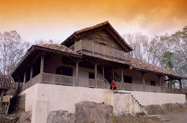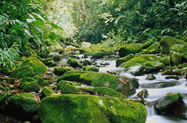Environment
Costa Rica accounts for only 0.03 percent of the earth's surface (has only 51.100km2). However it contains nearly 6 percent of the world's biodiversity. Its natural wealth, both in species and ecosystems, is partly explained by its geographical position. Situated between the North and South America continents, Costa Rica has served as a bridge of countless species of animals and plants for thousands of years. Another factor to consider is the broad expanse of both coasts: a Caribbean coast (255kms) and facing the Pacific Ocean (1103 kms). A mountain range also provides numerous microclimates and a territorial sea of 589.000km2.
The system of National Parks and Reserves covers an area of 1342 hectares or 25.6% of its land area. These areas include islands and beaches, rain forests and dry, active volcanoes, hot springs, caves, river canyons and waterfalls. This biological heritage, the product of millions of years of evolution, presents us a spectacle of a nature not processed and undomesticated. The services these ecosystems provide to humanity are manifold. On one side is environmental services: wood, timber, plants, barks, roots, leaves, seeds, fruits, flowers, to name a few, which have fueled the culture, industry and scientific research. On the other side is environmental benefits: control of erosion caused by rain and wind, water protection, soil, fixation and carbon storage, which mitigate the greenhouse effect and biodiversity.
Costa Rica has signed forty-five international environmental treaties (most ratified between 1990 and 2003). There have also been enacted numerous regulatory bodies such as the Organic Law of Ministry of Environment and Energy (MINAE, 1993), the Environment Law (1995), the Forestry Law (1996) and the Biodiversity Act (1998). Since the adoption of the latter, the conservation and sustainable environmental management has a greater specificity. The Act deals with the social demand to conserve and protect biodiversity and endangered species. Also includes measures on the social demand to conserve, protect and sustainably exploit biological resources to ensure the quality of life of future generations and the survival of natural heritage.
The administration of Costa Rica's biodiversity for the Ministry of Environment, Energy and Telecommunications (MINAET), and within it specifically the National System of Conservation Areas (SINAC), responsible for promoting the conservation and sustainable use of biodiversity in the country, concentrates heavily on their primary and secondary forests, mangroves, wetlands and forest plantations. The National Biodiversity Institute (INBio) was created as a private, nonprofit organization in 1989. Their work is to investigate, publicize and promote the sustainable use of biodiversity in the country. INBio has pioneered the establishment of research agreements worldwide in the search for chemicals, genes, etc.., present in plants, insects, marine organisms and microorganisms, which can be used by the pharmaceutical, medical, biotechnology, cosmetics , nutrition and agriculture industries. This institution has received important awards, both nationally and internationally, including the Prince of Asturias Prize (1995) and the Tech Museum 2003: Technology benefiting Humanity award (2003). The organization's heaquarters are open to the public and integrates scientific research, biodiversity, education and recreation.
You can now compensate the carbon offset from your airline travel to and from Costa Rica in www.fonafifo.com by contributing to the "Clean Trip" initiative.




